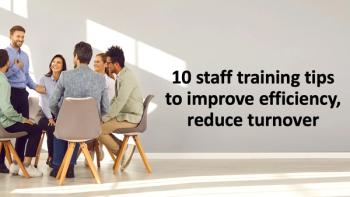
How to make the most of medical conferences
Medical conferences are high-energy fountains of inspiration and education, but how can you put those ideas into action once you get back home?
Medical symposia, industry conferences, and professional development workshops are great opportunities to network with peers, hear innovative ideas, and recharge professional passions. They also can be cognitively overwhelming. Sure, you’ll leave inspired to make improvements in your practice. But it can be difficult to hold on to those aspirations once you get back to the daily grind.
We asked physician practice “conference junkies” how they make the most of their time at conferences, including tips on how to keep those best practices top of mind and even put them into action.
Before the conference
Long before you board the plane, decide what you and your practice teams hope to learn from the specific event, suggests Owen Dahl, a practice management consultant in The Woodlands, Texas, and a frequent speaker at physician practice management conferences. “Planning needs to start before the conference, both on what the big organizational needs are and the goals of the individual,” he says. “Go with the expectation of identifying two or three major things that can be brought back.”
For first-time conference attendees, the conference experience can induce information overload, says KrisEmily McCrory, MD, FAAFP, a family medicine practitioner in Schenectady, N.Y. “Look at the schedule, and plan your days ahead of time,” she urges. You can’t possibly attend everything, so identify the sessions that relate specifically to your practice interests or may offer ideas on how to improve your processes.”
Study the conference agenda and identify a backup session in case your primary intended session is overbooked, canceled, or doesn’t offer the information you expected. But don’t feel pressured to marathon from one session to the next. In most cases, it’s counterproductive to attend too many sessions in a day. "You can end up with a fair degree of cognitive overload and, paradoxically, retain very little,” advises Saroj Misra, DO, FACOFP, chief of family medicine at St. John Macomb-Oakland Hospital in Warren, Mich., and a veteran of the conference circuit.
During the conference
It’s your conference dollar, so maximize your attendance by focusing on your educational goals and taking the opportunity to ask speakers questions, McCrory says. “For each session you attend, write down one or two action items you can take home. Try not to change your entire practice based on a single session, but use the pearls to make smaller, more manageable changes. See if the presenters are willing to share contact information-often they will be available to answer questions via email after you have had time to digest the material.”
Is a session’s content not what you’d hoped it would be? It’s not a sin to get up and switch to another session, so maximize your time by moving on to your Plan B session.
You’ll be tired at the end of each day, but don’t be tempted to skip any networking opportunities offered in the evenings. It’s a great way to exchange ideas with other attendees in an informal setting (be sure to keep your name tag on), and there are usually appetizers to snack on while you mingle.
Nearly every conference has a social media presence, so harvest those social media tools, McCrory adds. “Don't underestimate the connecting power of social media. If you don't have a Twitter account, consider getting one and using it for the conference. You will find other attendees you can connect with virtually and in real life, and you’ll be informed of impromptu or informal gatherings that might not be on the schedule.” It doesn’t hurt to make sure your LinkedIn profile is up-to-date, either, as some people like to send out invitations while talking to you on your phone. And even in this digital day and age, handing out old-fashioned business cards remains a great way to connect later.
After the conference
Once you unpack your suitcase, it’s easy for the conference inspirations to fade. Make a point of reviewing your take-home lessons or change-nuggets and sharing them with others in your practice. Most presenters offer downloadable materials from their presentations, but not all conferences keep those resources available forever-so be sure to download what you wish to keep within a week or so after the conference.
“Translating what you learned into what you do takes practice,” Misra notes. “Small, focused changes are easier. Try to pick one or two things you wish to change about the way you practice. Next, try to engage others in your practice. It may be a medical care change or a workflow change. Remember, you have to be able to explain succinctly what you think should be changed and why. If you have a weekly staff meeting or practice meeting, this might be an excellent place to introduce such ideas.”
Instituting changes in your practice means laying out a goals plan and considering all departments that may be affected. “Set a goal of achievement, such as three to six months to realize the benefits of a change,” Dahl suggests. “Small, incremental steps rather than a Big Bang approach may be the best way to go. The key factor is what makes sense and then what is possible to achieve.”
Pamela Tabar is a healthcare writer based in Medina, Ohio.
Newsletter
Optimize your practice with the Physicians Practice newsletter, offering management pearls, leadership tips, and business strategies tailored for practice administrators and physicians of any specialty.









